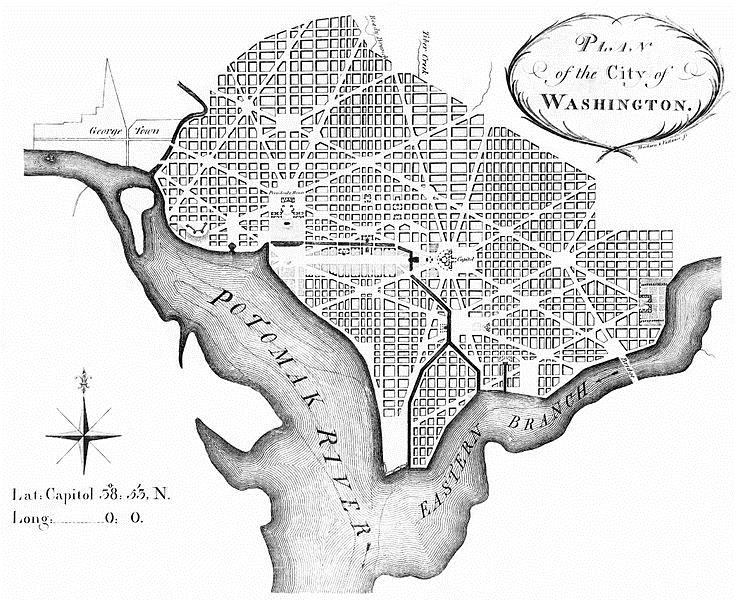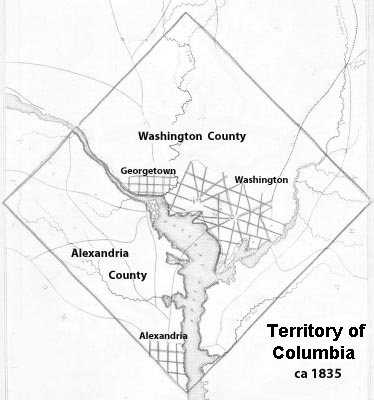The following article is by my good friend, Bill Dollarhide, taken from his book, District of Columbia Name Lists, 1600s-1997.
Prologue: For genealogists looking for evidence of their DC ancestors, access to records from the territory, county, city, and district jurisdictions may be necessary. The District of Columbia holds a unique status in this country’s political system, functioning the same as a state, a county, and a city. The Governments of the District and the City are the same. Some functions are done under the name District of Columbia, others under the name of the city of Washington, DC. Specific functions usually performed by state–level governments include state courts, driver licensing, liquor control, unemployment compensation, food and drug inspection, and professional licensing, just to name a few. It is the mayor of the city of Washington who administers these state-level functions; plus the mayor manages city-level functions such as police and fire departments. The “state court” of the District of Columbia is also unique – it is actually a circuit division of the Supreme Court of the United States, and the “state judge” is usually the Chief Justice of the Supreme Court. This current system was preceded by several different governmental structures, jurisdictions and names; and local political control changed often. For genealogical research in the District of Columbia, the following timeline of events should help any genealogist understand the area with an historical and genealogical point of view:
1790. July. Residence Act. The U.S. Congress approved the creation of a permanent national capital district. The 1783 U.S. Constitution had called for a “…district, not exceeding ten miles square…” with the exact site to be selected by the President. In 1790, President George Washington, a former surveyor, sketched a ten-mile square that crossed the Potomac River, encompassing the existing towns of Georgetown on the Maryland side, and Alexandria on the Virginia side.
1790. August. First Federal Census. Although now part of the new capital district, the town of Georgetown was still enumerated as part of Maryland (census extant); and the town of Alexandria was enumerated as part of Virginia (census lost).
1791. The City of Washington was first laid out and named in September. However, Georgetown remained the main community in the northern part of the capital district for several more years.

The L’Enfant Plan for Washington, D.C., as revised by Andrew Ellicott in 1792. The design for the City of Washington was largely the work of Pierre Charles L’Enfant, a French-born architect, engineer, and city planner who first arrived in the colonies as a military engineer during the American Revolutionary War. In 1791, President Washington commissioned L’Enfant to lay out the design of the new capital based on plans of cities such as Amsterdam, Paris, Frankfurt, Karlsruhe, and Milan brought from Europe by Thomas Jefferson in 1788. L’Enfant’s design envisioned a garden-lined “grand avenue” approximately 1 mile in length and 400 feet wide in the area that is now the National Mall. In March 1792, President Washington dismissed L’Enfant due to his insistence on micromanaging the city’s planning, which had resulted in conflicts with the three commissioners appointed to supervise the capital’s construction. Andrew Ellicott, who had worked with L’Enfant surveying the city, was then commissioned to complete the plans. Though Ellicott made revisions to the original plans, including changes to some street patterns, L’Enfant is still credited with the overall design of the city. (Map source: Wikipedia).
1800. The capital of the United States was officially moved from Philadelphia to Washington in December. The 1800 federal census for the inhabitants of the national capital district was taken as part of the Maryland and Virginia enumerations. The population of the Georgetown/Washington side was 8,144, while the Alexandria side had 5,959 residents.
1801. Territory of Columbia. The Organic Act of 1801 established “The Territory called Columbia” as a jurisdiction exclusively under the control of Congress. Columbia, a poetic name for the United States in use at that time, was first used in 1801 to describe the ten-mile square capital district, but before it was a “district,” it was a “territory.” The 1801 Act also established a territorial judicial system, provided for a committee in Congress to manage the affairs of the territory; and created two counties, Washington County on the northern side of the Potomac, and Alexandria County on the southern side. From 1790-1801, both Virginia and Maryland considered the residents in their ceded areas as citizens, qualified to vote in state and federal elections; and they were included in the federal censuses taken there in 1790 and 1800 as part of Virginia and Maryland. The 1801 Act essentially disenfranchised the capital district residents, who now had no right to vote, no representation in Congress, and no home rule.
1814. British troops burned the capitol and other federal buildings during the War of 1812. Contrary to popular belief, no original federal censuses were lost in the fires, with the possible exception of the 1810 Territory of Columbia schedules. None of the other federal census name lists had been moved to Washington yet. That did not happen until after an 1830 law asked for the clerks of the district courts in all states to send the original copies to the U.S. Secretary of State’s Office in Washington.
1820. Congress amended the charter of the city of Washington for the direct election of the mayor by resident voters.

1846. Congress passed a law returning the city of Alexandria and Alexandria County to the state of Virginia, an act referred to as a retro-cession.
1848. Congress adopted a new charter for the City of Washington and expanded the number of elected offices to include a board of assessors, a surveyor, a collector and a registrar.
1871. District of Columbia. The elected mayor and council of Washington City and Georgetown, and the County Levy Court were abolished by Congress and replaced by a governor and council appointed by the president. An elected House of Delegates and a non-voting delegate to Congress were created. In this Act, the jurisdiction and territorial government came to be called the District of Columbia, combining the governments of Georgetown, the City of Washington and the County of Washington.
1874. The territorial government of the District of Columbia was abolished, including the non-voting delegate to Congress. Three temporary commissioners and a subordinate military engineer were thereafter appointed by the president.
1878. In the Organic Act of 1878, Congress established the District of Columbia government as a municipal corporation governed by three commissioners appointed by the President. This form of government continued until 1973.
1895. No longer a city, the area of Georgetown was officially added to the city of Washington. The boundaries of the City of Washington and the District of Columbia were now the same.
1961. The 23rd Amendment to the Constitution gave District residents the right to vote for president.
1973. Congress approved the District of Columbia Self-Government and Governmental Reorganization Act, which established an elected mayor and a 13-member council.
1978. Congress approved the District of Columbia Voting Rights Amendment, which would have given District residents voting representation in the House and the Senate. However, the proposed constitutional amendment was not ratified by the necessary number of states (38) within the allotted seven years.
1980. District voters approved the District of Columbia Statehood Constitutional Convention of 1979, which called for convening a state constitutional convention.
1982. After a constitutional convention, a Constitution for the State of New Columbia was ratified by District voters. But, no action by Congress was taken.
1983-1993. Another state constitution was drafted, which again referred to the proposed state as New Columbia. Since 1983, more than a dozen statehood bills were introduced in Congress, but only two bills were reported out of the committee of jurisdictions: In 1992, the U.S. House of Representatives approved an enabling act for statehood for Washington, DC, but the U.S. Senate did not approve the measure. The second of these bills made it to the House floor in November 1993 for the debate and vote on D.C. statehood. It was defeated in the House of Representatives by a vote of 277 to 153.
1994-2013. For twenty years after the 1993 vote, there were bills introduced each year to grant statehood to the District of Columbia, but there were no congressional hearings, and none were ever brought to a vote.
2014-2015. The U.S. Senate Committee on Homeland Security and Government Affairs held a hearing on bill S. 132 which would have created a new state out of the current District of Columbia, similar to the 1993 bill. On Jan 25, 2015, A new bill was introduced by U.S. Sen. Tom Carper (D-Del.), ranking member of the Homeland Security and Governmental Affairs Committee, leading a group of 17 senators in introducing legislation that would grant Washington, D.C. full statehood. Rep. Eleanor Holmes Norton (D-D.C.) introduced companion legislation in the House, H.R. 317, in January.
2016. Apr. District Mayor Muriel Bowser called for a city-wide vote on whether the District of Columbia should become a state. A proposed state constitution followed, one that would make the Mayor of the District of Columbia the governor of the proposed state, and the members of the DC City Council would make up the proposed House of Delegates.
2016. Nov. The voters of the District of Columbia voted for statehood with a 86% majority in favor.
2017. Mar. The Washington D.C. Admission Act was introduced in the U.S. Senate. According to GovTrack: “…this bill is in the first stage of the legislative process. It was introduced into Congress on March 1, 2017. It will typically be considered by committee next before it is possibly sent on to the House or Senate as a whole. Prognosis: 3% chance of being enacted according to Skopos Labs.”
Further Reading:
District of Columbia Name Lists, 1600s-1997 (printed Book), softbound, 73 pages, Item FR0225.
District of Columbia Name Lists, 1600s-1997 (PDF eBook), 73 pages, Item FR0026.
